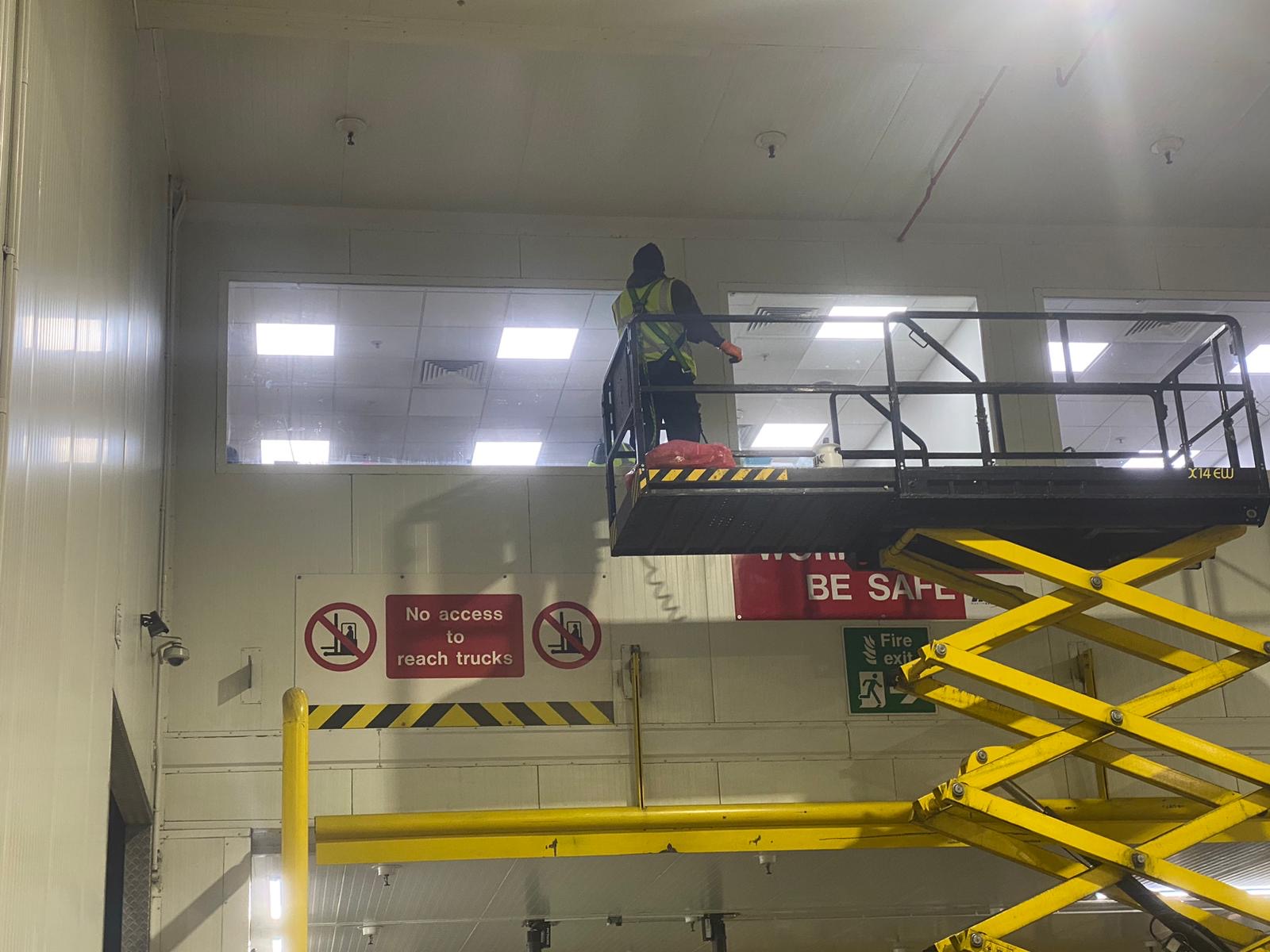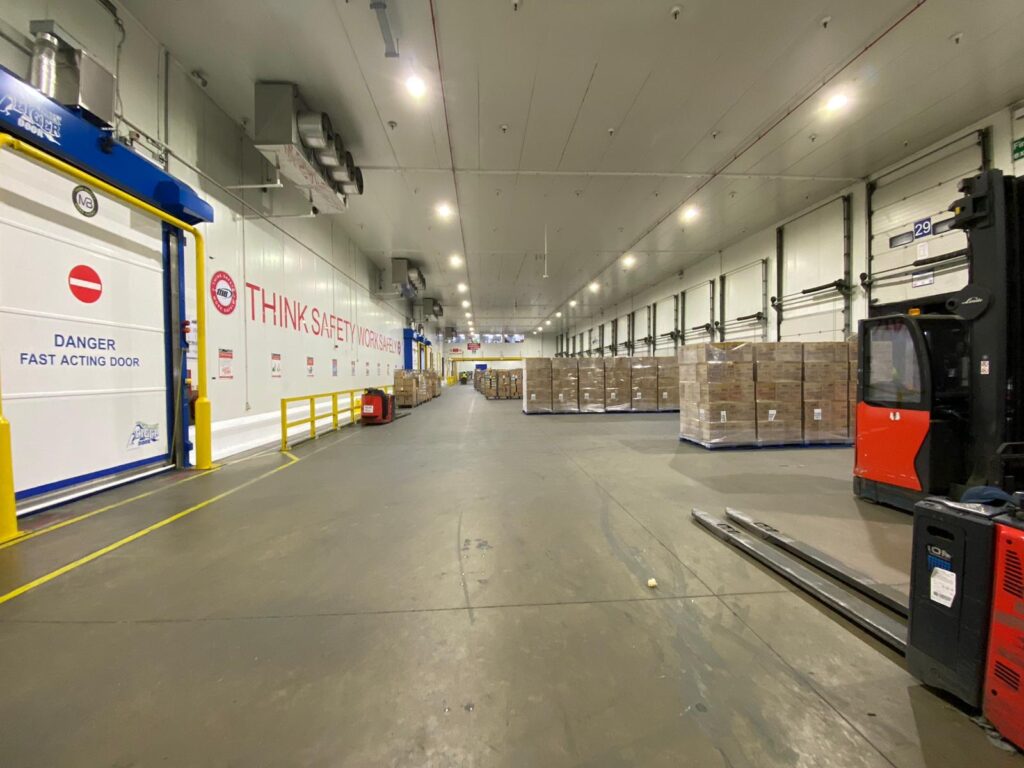Commercial Chiller Cleaning
Commercial Freezer Cleaning
Ambient Storage Cleaning
Maintaining hygienic conditions in commercial storage environments—whether ambient, chilled, or frozen—is essential for protecting public health, ensuring regulatory compliance, and preserving the integrity of stored goods. One often overlooked but critical aspect of hygiene in these spaces is high-level cleaning, including ceilings, overhead pipework, ducting, lighting, and high-level walls. These areas are prone to accumulating dust, mould, and debris, which can compromise product safety if not properly maintained.
This article explores UK best practices in high-level cleaning for storage areas, reviews relevant legislation, and outlines practical strategies to help facility managers uphold the highest standards.
Why High-Level Cleaning Matters
Neglecting high-level cleaning can lead to a buildup of contaminants that may:
- Drop onto products, posing food safety risks.
- Compromise air quality.
- Encourage pest infestations.
- Cause equipment breakdowns due to restricted airflow or insulation issues.
- Violate regulatory standards, leading to enforcement action.
High-Level Walls: A Key Focus
In addition to ceilings and overhead fixtures, high-level walls are particularly prone to condensation, dust accumulation, and microbial growth—especially in chilled and frozen environments. Cleaning these vertical surfaces is essential to maintaining an all-encompassing hygiene standard.
Legal and Regulatory Requirements in the UK
Several UK laws and industry standards govern the cleaning and maintenance of commercial storage spaces, including high-level areas:
This primary legislation requires that food is not rendered harmful through contamination. Under this Act, failure to maintain clean storage areas can be deemed a criminal offence.
2. The Food Hygiene (England) Regulations 2013
These regulations implement the EU’s retained hygiene standards. They require that all food premises are clean and in good repair, and that cleaning schedules are followed and documented.
3. Hazard Analysis and Critical Control Points (HACCP)
A mandatory approach under UK law, HACCP systems must identify all contamination risks—including those from dust or mould on overhead surfaces—and define effective control measures like routine cleaning of high-level walls and ceilings.
4. Health and Safety at Work etc. Act 1974
Employers have a duty to provide a safe working environment. This includes eliminating hazards from falling debris, contaminated air, or mould spores, which can arise from unclean high-level areas.
5. Control of Substances Hazardous to Health Regulations 2002 (COSHH)
These regulations require businesses to control risks from hazardous substances—including bioaerosols, mould, and allergens—that may accumulate on high-level structures and walls.
6. British Retail Consortium (BRCGS) Global Standards
For businesses aiming to maintain certification, the BRCGS Food Safety standard stipulates that the building must be maintained in good condition, with effective cleaning schedules for hard-to-reach areas like high walls and ceilings.
This British Standard provides guidance on the inspection and cleanliness of ventilation systems, essential in cold storage environments where ducting often runs at height.
Best Practice for High-Level Cleaning in Storage Environments
Implementing a well-structured and risk-based approach is key. Here are essential best practices:
1. Create a Comprehensive Cleaning Schedule
Include high-level walls, ceilings, light fixtures, HVAC units, and beams.
- Daily: Spot checks for debris and visible contamination.
- Weekly: Clean accessible high-level surfaces.
- Monthly: Wipe down high-level walls and inspect ventilation outlets.
- Quarterly: Deep clean high areas using scaffolding or MEWPs (Mobile Elevating Work Platforms).
- Annually: Full audit and decontamination of all high-level structures.
2. Use Suitable Cleaning Equipment and Materials
- Dry vacuum systems to safely remove dust and allergens.
- Telescopic tools to reach difficult areas without the need for constant working at height.
- Food-safe detergents and sanitisers that are effective in cold or damp environments.
- Non-corrosive agents suitable for stainless steel surfaces often found in cold stores.
3. Staff Training and Safety Protocols
- Full training in Working at Height Regulations 2005.
- Use of PPE: gloves, goggles, harnesses, insulated footwear.
- Risk assessments and permits to work in frozen or chiller zones.
- Emphasise correct handling and dilution of chemical cleaning agents.
4. Documentation and Verification
- Maintain cleaning records as required by HACCP and BRCGS.
- Conduct ATP (Adenosine Triphosphate) swab testing to verify biological cleanliness.
- Schedule independent hygiene audits at least annually.
Environment-Specific Considerations
Ambient Storage
- Risk of dust and pest ingress is higher.
- Emphasise frequent dust removal from high-level walls, ventilation grilles, and exposed pipework.
- Keep air circulation pathways clean to prevent airborne contamination.
Chiller Storage
- Humidity levels support microbial growth—particularly on high-level walls and cold pipe lagging.
- Watch for condensation, and use fungicidal agents regularly.
- Surfaces may need pre-heating prior to cleaning to avoid freezing of cleaning agents.
Frozen Storage
- Cold inhibits microbial growth, but encourages ice formation and dust adhesion.
- Ice can build up on ceilings and high-level walls, potentially leading to collapse or product contamination.
- Cleaning agents must be suitable for sub-zero use, and staff exposure times must be limited.
Why Outsource High-Level Cleaning?
Engaging professional high-level cleaning contractors can ensure:
- Compliance with TR19® and BS EN standards.
- Reduced risk to in-house staff.
- Access to specialist tools (e.g., cherry pickers, dry ice blasting).
- Certification and audit-ready documentation.
Ensure contractors are SafeContractor or CHAS accredited, and experienced with cold storage environments.
Key Benefits of Effective High-Level Cleaning
- ✅ Improved food safety and product integrity
- ✅ Compliance with UK legislation and retailer standards
- ✅ Increased equipment lifespan and reduced breakdowns
- ✅ Enhanced pest prevention
- ✅ Improved staff morale and workplace safety
- ✅ Reduced risk of enforcement action
Final Thoughts
High-level cleaning of ambient, chiller, and frozen storage areas—including high-level walls—is not just a hygiene concern, but a legal and operational imperative. By adopting a proactive and structured approach, commercial businesses can ensure a clean, compliant, and efficient environment.
💡 Top tip: Incorporate high-level cleaning into your HACCP plan and ensure it is reviewed every six months or following any structural or usage change








